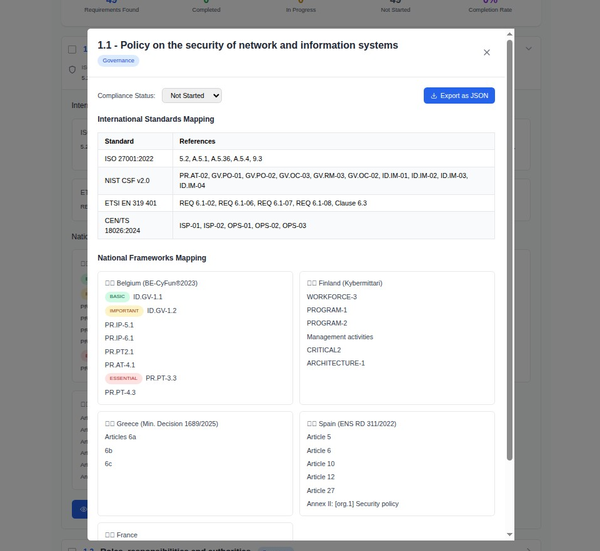A Comprehensive Guide to U.S. State Data Breach Notification Compliance

Introduction
In the United States, each state has its own set of data breach notification laws, creating a complex compliance landscape for businesses. This article provides an overview of these laws across all 50 states, the District of Columbia, Guam, Puerto Rico, and the Virgin Islands, highlighting the key aspects of compliance in each jurisdiction.


State-by-State Breakdown
- Alabama: Notification within 45 days of breach discovery. Applies if Alabama residents are affected.
- Alaska: Notification to individuals and the Attorney General if more than 500 residents are affected.
- Arkansas: Notification to individuals and the Attorney General for breaches affecting over 1,000 residents.
- California: Reporting to the Attorney General for breaches affecting more than 500 residents.
- Colorado: Notification within 30 days of breach discovery.
- Connecticut: Notification to individuals, with credit monitoring services offered in certain cases.
- Delaware: Notification within 60 days of breach discovery.
- Florida: Reporting to the Department of Legal Affairs for breaches affecting 500 or more residents.
- Georgia: Notification to individuals if personal information is compromised.
- Hawaii: Notification to affected individuals and the Office of Consumer Protection.
- Idaho: Notification within a reasonable time frame.
- Illinois: Notification to more than 500 residents must include the Attorney General's Office.
- Indiana: Notification to individuals and the Attorney General for breaches affecting over 1,000 residents.
- Iowa: Notification to individuals and the Attorney General for breaches affecting over 500 residents.
- Kansas: Notification within a reasonable time frame.
- Kentucky: Prompt notification to affected individuals.
- Louisiana: Notification within 60 days of breach discovery.
- Maine: Notification to individuals and the Attorney General, with public listing of reported breaches.
- Maryland: Reporting to the Attorney General's Office for substantial breaches.
- Massachusetts: Reporting to the Office of Consumer Affairs and Business Regulation for potential state resident impact.
- Michigan: Notification to individuals and the Attorney General for breaches affecting over 500 residents.
- Minnesota: Notification to individuals and the state.
- Mississippi: Notification within a reasonable time frame.
- Missouri: Prompt notification to affected individuals.
- Montana: Notification to individuals and the Attorney General for breaches affecting over 1,000 residents.
- Nebraska: Notification within a reasonable time frame.
- Nevada: Notification within 60 days of breach discovery.
- New Hampshire: Notification to individuals and the Attorney General.
- New Jersey: Notification to individuals, with potential state government notification.
- New Mexico: Notification within 45 days of breach discovery.
- New York: Notification to the state for resident-impacting breaches.
- North Carolina: Reporting to individuals and the Attorney General.
- North Dakota: Notification within a reasonable time frame.
- Ohio: Timely notification to affected individuals.
- Oklahoma: Notification within a reasonable time frame.
- Oregon: Notification to individuals and potentially the Attorney General.
- Pennsylvania: Prompt notification to affected residents.
- Rhode Island: Notification within 45 days of breach discovery.
- South Carolina: Notification to individuals and the Department of Consumer Affairs.
- South Dakota: Notification within 60 days of breach discovery.
- Tennessee: Notification within 45 days of breach discovery.
- Texas: Reporting to the Attorney General for breaches affecting at least 250 residents.
- Utah: Notification within a reasonable time frame.
- Vermont: Notification to individuals and the Attorney General.
- Virginia: Notification to affected individuals and the Attorney General.
- Washington: Reporting to the Attorney General for breaches affecting 500 or more residents.
- West Virginia: Notification within a reasonable time frame.
- Wisconsin: Prompt notification to affected individuals.
- Wyoming: Notification within a reasonable time frame.
- District of Columbia: Notification to affected individuals and the Attorney General.
- Guam: Notification to affected individuals and the Attorney General.
- Puerto Rico: Notification to affected individuals and the Department of Consumer Affairs.
- Virgin Islands: Notification to affected individuals and the Department of Licensing and Consumer Affairs.
Conclusion
Navigating the patchwork of data breach notification laws in the U.S. requires a thorough understanding of each jurisdiction's specific requirements. Businesses must stay informed and agile to ensure compliance, especially those operating across multiple states or territories. Developing a comprehensive data breach response plan that considers these varied legal requirements is essential for effective compliance and maintaining consumer trust.







